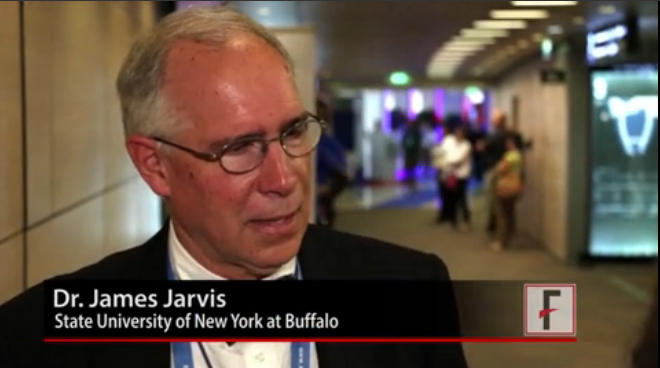User login
PARIS – Thanks to microarray analysis of gene expression in patients with juvenile idiopathic arthritis, response to treatment at 12 months can be predicted after just 4 months of therapy, based on a longitudinal analysis of whole blood samples from children participating in the TREAT study.
The prediction of active versus inactive disease could be made even more strongly when stratifying patients based on the presence of rheumatoid factor (RF), which is an "exciting" finding, study investigator Dr. James Jarvis said in a video interview at the annual European Congress of Rheumatology. "We’ve known for a long time that children with rheumatoid factor–positive disease are just harder to treat."
The National Institutes of Health–funded TREAT (Trial of Early Aggressive Drug Therapy in Juvenile Idiopathic Arthritis) study compared treatment with methotrexate alone against methotrexate plus etanercept for children with newly diagnosed juvenile idiopathic arthritis. The current analysis found that treatment in RF-positive patients led to changes in fewer genes than in RF-negative patients, and also changed the expression of different genes than in those with RF-negative disease. Dr. Jarvis is chief of allergy/immunology and rheumatology in the pediatrics department at the University at Buffalo, The State University of New York.
The video associated with this article is no longer available on this site. Please view all of our videos on the MDedge YouTube channel
PARIS – Thanks to microarray analysis of gene expression in patients with juvenile idiopathic arthritis, response to treatment at 12 months can be predicted after just 4 months of therapy, based on a longitudinal analysis of whole blood samples from children participating in the TREAT study.
The prediction of active versus inactive disease could be made even more strongly when stratifying patients based on the presence of rheumatoid factor (RF), which is an "exciting" finding, study investigator Dr. James Jarvis said in a video interview at the annual European Congress of Rheumatology. "We’ve known for a long time that children with rheumatoid factor–positive disease are just harder to treat."
The National Institutes of Health–funded TREAT (Trial of Early Aggressive Drug Therapy in Juvenile Idiopathic Arthritis) study compared treatment with methotrexate alone against methotrexate plus etanercept for children with newly diagnosed juvenile idiopathic arthritis. The current analysis found that treatment in RF-positive patients led to changes in fewer genes than in RF-negative patients, and also changed the expression of different genes than in those with RF-negative disease. Dr. Jarvis is chief of allergy/immunology and rheumatology in the pediatrics department at the University at Buffalo, The State University of New York.
The video associated with this article is no longer available on this site. Please view all of our videos on the MDedge YouTube channel
PARIS – Thanks to microarray analysis of gene expression in patients with juvenile idiopathic arthritis, response to treatment at 12 months can be predicted after just 4 months of therapy, based on a longitudinal analysis of whole blood samples from children participating in the TREAT study.
The prediction of active versus inactive disease could be made even more strongly when stratifying patients based on the presence of rheumatoid factor (RF), which is an "exciting" finding, study investigator Dr. James Jarvis said in a video interview at the annual European Congress of Rheumatology. "We’ve known for a long time that children with rheumatoid factor–positive disease are just harder to treat."
The National Institutes of Health–funded TREAT (Trial of Early Aggressive Drug Therapy in Juvenile Idiopathic Arthritis) study compared treatment with methotrexate alone against methotrexate plus etanercept for children with newly diagnosed juvenile idiopathic arthritis. The current analysis found that treatment in RF-positive patients led to changes in fewer genes than in RF-negative patients, and also changed the expression of different genes than in those with RF-negative disease. Dr. Jarvis is chief of allergy/immunology and rheumatology in the pediatrics department at the University at Buffalo, The State University of New York.
The video associated with this article is no longer available on this site. Please view all of our videos on the MDedge YouTube channel
AT THE EULAR CONGRESS 2014
